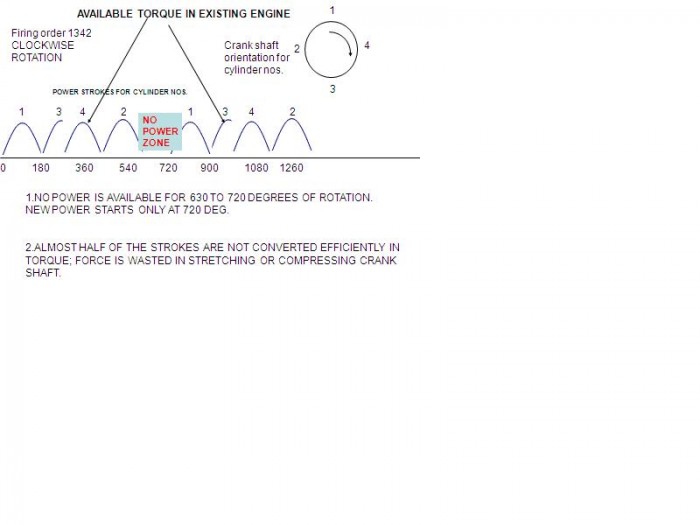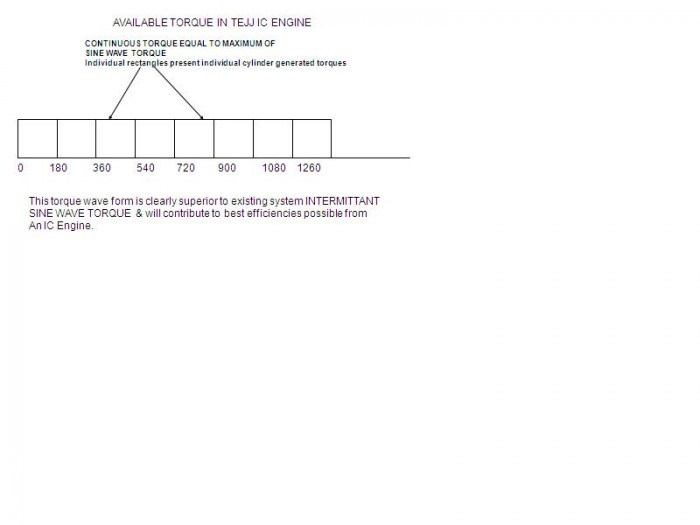
Home List your patent My account Help Support us
TEJJ CONSTANT TORQUE IC ENGINE
[Category : - OTHER- Automotive Accessories - DESIGN PATENTS]
[Viewed 6038 times]
is converted in to rotary motion for wheel through crankshaft. This was most appropriate technology when the engine was invented. However, with continuously rising fuel prices around the world, many attempts are being made for improving engine efficiency.
I have studied existing technology in detail & have found out following disadvantages with existing system.
DISADVANTAGES IN EXISTING SYSTEM
1. The torque generated is always in a sine wave form.
2. Although, fuel combustion exerts tremendous force on piston from TDC to BDC (can be considered constant for any particular power stroke); all of it is never converted in to desired torque. When piston is near TDC or BDC, the force is wasted in compressing / stretching crankshaft radial arms towards / away from crankshaft bearings. Due
to this repetitive cyclic force, crankcase is required to be designed adequately strong & robust for bearing non converted force from Pistons.
3. Due to sine wave nature of torque conversion, maximum torque is available ONLY AT CRANKSHAFT ROTATION AT MULTIPLES OF 90 deg..
For all other times, the torque available is LESS THAN MAXIMUM POSSIBLE.
4. For a 4 cylinder engine with cranks placed at 90 deg. apart & firing order 1,3,2,4; cylinder 1 (say) has power stroke from 0 deg. to 180 deg.of crankshaft rotation; then other cylinders will fire as under
• Cylinder 1: 0 deg. to 180 deg..
• Cylinder 3: 180 deg. to 360 deg..
• Cylinder 2: 270 deg. to 450 deg..
• Cylinder 4: 450 deg. to 630 deg..
For cylinder 1, next power stroke starts at 720 deg. only & hence it can be seen that from 630 deg. to 720 deg., there is no power available in any of the cylinders. Engine has to cross this zone only by means of inertia of the over all system.
Considering all these disadvantages, I have developed a new concept in IC Engine, which WILL NOT HAVE ANY OF ABOVE DISADVANTAGES.
I have named it TEJJ IC ENGINE having following advantages:
ADVANTAGES OF TEJJ IC ENGINE
1. This Engine WILL PRODUCE CONSTANT TORQUE OVER ALL
POSITIONS OF CRANKSHAFT ROTATION. Torque wave will be a
rectangular one.
2. The torque will be comparable to that of ELECTRIC MOTOR.
3. As no force from piston will be wasted in exerting undue force on crankshaft bearings, crankcase design can be made relatively lighter.
4. Torque available will be EQUAL TO MAXIMUM POSSIBLE TORQUE of existing sine wave torque at 90 deg. multiples.
5. This engine can be easily made in existing plants since It is only addition / modification of components & rearrangement of existing engine using ALREADY PROVEN COMPONENTS ELSE WHERE.
6. No new technology yet to be tasted is used for this invention.
7. Work done PER POWER STROKE of ENGINE WILL BE ALMOST 55%
HIGHER THAN THAT IN AN EXISTING SINE WAVE IC ENGINE.
8. This will lead to TREMENDOUS INCREASE OF ENGINE EFFICIENCY / MILAGE FROM VEHICLE.
9. This Engine can be used for all IC engine applications as at present.
10. This Engine can be used for all 2-stroke / 4-stroke engines running on ANY FUEL.
11. The investment made for developing / buying this technology will enabel the buyer to claim carbon credits.
12. Due to higher power available, existing 2nd, 3rd, 4th & 5th gear ratios can be used for 1st, 2nd, 3rd & 4th gear for vehicles fitted with TEJJ ENGINE. 5TH Gear can have more over drive & suitable gear ratio can be easily devised.
I assure that concept is fully ready with drawings, animated presentations etc & only shop floor designing / manufacturing is remaining.
Links with relevant graphics are available at “Link
 Patent publications:
Patent publications: No published information
No published informationAsk the inventor for a copy of the filed application
Asking price:
100,000 USD
100,000 USD


[ Home | List a patent | Manage your account | F.A.Q.|Terms of use | Contact us]
Copyright PatentAuction.com 2004-2017
Page created at 2025-11-26 3:56:12, Patent Auction Time.
 Great invention
Great invention